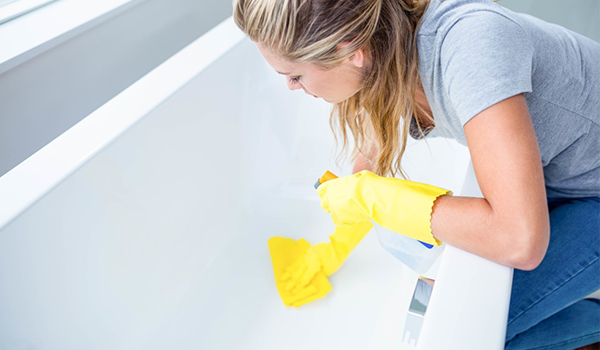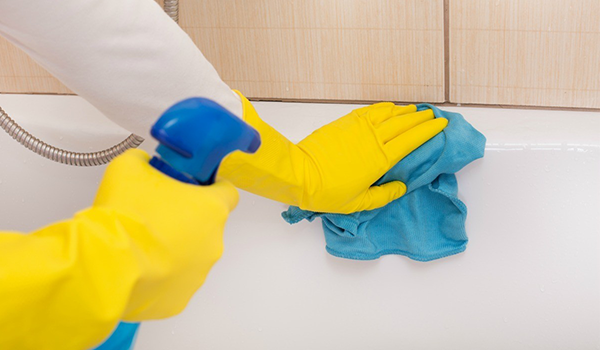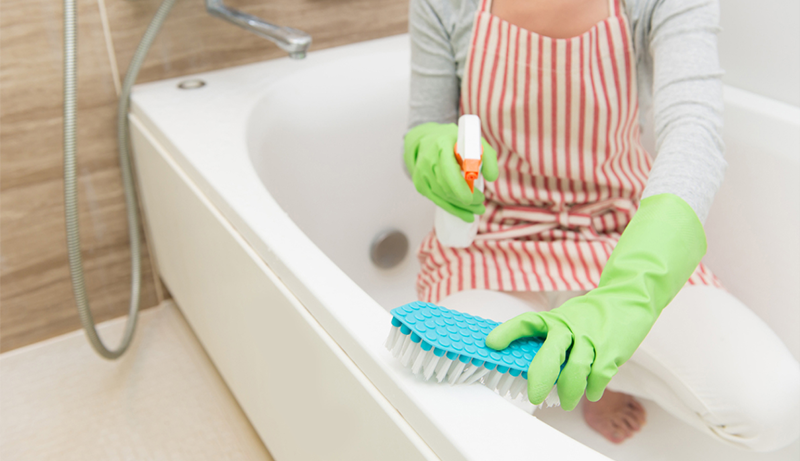Cleaning a plastic tub surround is never simple because if you make a mistake, scratches might appear on your brand-new bathtub, ruining its beautiful appearance. The issue is how to properly remove soap scum and debris from the surface without harming the fabric.
Some of the finest cleaning solutions for a plastic tub surround are vinegar, dish soap, bleach solution, homemade degreaser, baking soda, and all-purpose cleansers. When cleaning a plastic tub enclosure, use soft materials like sponges, rags, or microfiber or terry towels.
Avoid using scouring pads, steel wool, and melamine sponges since they can damage the surface. Use of commercial solvents or abrasive cleaning agents is absolutely prohibited. Let us go through all the specifics for maintaining the pristine appearance of your plastic tub.
6 Practical Ways to Clean a Plastic Tub Surround
If done correctly, cleaning a plastic tub surround does not have to be difficult or time-consuming. For the greatest results, it’s important to use gentle cleaning agents like vinegar, baking soda dish soap, bleach, mixer degreaser, and all-purpose cleansers.
Vinegar for Hard Water Stains, Method 1
Use vinegar to give your plastic tub enclosures a spotless shine. Vinegar is a versatile cleanser that works well to get rid of smells, hard water stains, filth, and grime.
Step 1: is as simple as filling a spray bottle with white vinegar and misting it over the oily tub surface.
Step 2: Let the vinegar stay for 15 minutes before removing it with a gentle sponge or microfiber towel.
Step 3: Use fresh water to rinse away any last bits of residue.
You may replace the vinegar with beautiful lemon juice for an even more energizing scent.
Baking soda, second method

Another excellent go-to cleaner for plastic tub surrounds is baking soda. Grease and filth may be removed effectively without using harsh chemicals.
Step 1: Prepare a thick paste of baking soda with the consistency of peanut butter or toothpaste. Apply the baking soda paste over the oily surfaces using your fingertips or a clean, soft towel.
Step 2: After letting the baking soda paste remain for five minutes, gently scrape away any last bits of filth and grime using a gentle sponge or scrub brush.
Step 3: Rinse the baking soda paste away with some clean water and enjoy your plastic tub surround once it has dried.
Method 3. Dish Soap for Light Soap Scum and Dirt
Light soap scum and grime may be removed off a plastic tub surround with dish soap, which is both efficient and inexpensive. Cleaning a plastic container surrounded with dish soap:
Step 1: In a spray bottle, combine one gallon of warm water with two teaspoons of dish soap by vigorously shaking the mixture.
Step 2: Spray the soapy concoction onto the plastic tub surround and wait at least five minutes before cleaning.
Step 3: Scrub the surface of the tub surround with a microfiber cloth or terry cloth towel until all filth and grime is gone.
Step 4: When you’ve finished washing, rinse your hands with clean water to remove any remaining soap. Prior to utilizing the plastic tub surround again, let it thoroughly dry off.
Method 4. Bleach
Strong stains on plastic tub surrounds that cannot be cleaned with normal dish soap alone can be removed with bleach. However, it should be used with caution since if not applied correctly, it might harm some surfaces.
Step 1: To protect your skin from any splashes or spills that may happen during the cleaning procedure, put on protective gloves before handling any bleach solutions.
Step 2: In a dish or bucket, combine two teaspoons of bleach with two cups of water to make a bleach solution.
Step 3: Dip a cleaning implement, such as a brush with soft bristles, into the bleach solution. Before applying it against the surface of your plastic tub surround, let it rest for 30 to 60 minutes.
Step 4: Scrub away at stubborn stains in slow, circular strokes throughout the whole surface area, until they are no longer apparent.
Step 5: After each application of bleach, thoroughly rinse the area with clean water to remove any bleach residue.
Step 6: After fully drying, allow the plastic tub surround to be utilized once again.
Method 5. Mixer Degreaser
This technique uses hot water, dish soap, baking soda, and white vinegar to make an efficient cleaning solution that removes stubborn filth from plastic tub surrounds.
Step 1: To begin this procedure, you will need to prepare the mixture by putting one part vinegar and one part baking soda together in a basin.
Step 2: Then, add three parts hot water and one tablespoon of dish soap. The final step is to thoroughly combine the solution by stirring it with a spoon.
Step 3: After everything is prepared, dunk a microfiber cloth in this mixture and then gently clean the plastic tub that surrounds it.
Step 4: After thoroughly cleaning the targeted area, use cold water to rinse away any lingering grime.
Method 6. All-Purpose Cleaners for Hard Stains Method
Because of the substances they contain, all-purpose cleaners are an excellent choice for effectively removing grease and other tough stains from plastic tub enclosures. These cleaning agents are mild on surfaces so as not to harm them.
Step 1: First, spray your cleanser directly into the portion of the plastic tub surround that is in need of repair. Let it to rest for a while so that it may absorb any dirt or grime that may be on the surface.
Step 2: Gently cleanse the stain until it has been removed using a soft cloth or sponge dipped in warm water after letting it sit for a few minutes.
Step 3: After finishing, rinse any leftover material with fresh water.

Which Cleaning Products Are Available?
One is vinegar
Vinegar (lemon juice) is a powerful cleaning solution that may be used on plastic bathtub surrounds. Its acidic components can aid in clearing away debris from the surface, including tough dirt and soap scum.
Modest Dish Soap:
The plastic tub surround may also be cleaned with mild dish soap because it is soft yet still excellent at removing filth and grime.
Dilution of Bleach
Another excellent method for cleaning bathtub surrounds is diluted bleach. Although it can aid in sanitizing the surface, its concentrated form should never be utilized since it might harm the plastic surface.
Baking soda
Another great option for cleaning a plastic tub surround is baking soda paste. It is safe to use on the majority of surfaces and effectively removes dirt and grime with gentle exfoliation.
General Cleaners:
Due of their special formulation for this function, commercial all-purpose cleaners are normally safe to use on plastic tub surrounds. Be sure to read the label carefully for crucial information like “non-abrasive” and whether it is appropriate for materials like plastic, ABS, polystyrene, or acrylic.
What Cleaning Items Must You Steer Clear Of?
There are several cleaning agents that have to be avoided when using them on a plastic or ABS tub enclosure.
Scouring Powders: Since they might scratch or harm plastic, abrasive cleansers like scouring powders shouldn’t be used on any surface that is made of plastic.
Solvents: It’s crucial to keep in mind that you should never use turpentine, mineral spirits, or acetone on any sort of plastic surface. They could leave behind residues that are harmful to the substance.
Chemical cleansers that are too abrasive: Chemical cleaners that are too abrasive include oven cleaners and drain cleaners. Because of their caustic nature, they could etch the skin or worse, harm the surface.
What Cleaning Supplies Should You Use?
Microfiber towels
Microfiber cloths should be used to clean a plastic tub surround thoroughly. Because to their excellent absorption capacity, they can readily gather filth, dust, and dirt without leaving any streaks or residue.
Microfiber cloths are available in a range of sizes and may be cleaned and used repeatedly. Using them won’t harm the plastic tub because they are soft on its surface.
Towel Made of Terry:
Using something more abrasive, such as a terry cloth towel, may be advisable if the dirt is very tough to get rid of and obstinate. They may more easily break up dirt because they have greater texture.
While terry cloth towels also have some absorbency, they require more frequent replacement than microfiber towels since they degrade fast after washing.
supple sponges
As they are made to reach into corners and other spaces that could otherwise go uncleaned, soft sponges are especially helpful for cleaning the plastic tub surrounds. Also, they won’t scrape the tub’s surface, allowing for safe cleaning.
Scrubbers or soft rags:
Soft rags or scrubbers may also be used, but only if absolutely required. If not handled properly, these instruments can leave scratches, therefore attention should be exercised when using them for stubborn stains or debris.
What Cleaning Products Are Not Recommended?
Steel Wool: A steel wool pad in particular is particularly harmful since it is overly abrasive even when used to remove difficult filth due to its coarseness. Hence, it should never be used to clean any kind of plastic tub surround surface.
Scouring Pads: Because to their abrasive texture, scouring pads may also cause itching and should not be used.
Melamine Sponges: Melamine sponges don’t leave deep scratches like steel wool because of their softness. Their irregular texture nonetheless makes it possible for small scratching to occur, ruining the look of a smooth finish around a bathtub.
Can deteriorated plastic be made whiter?
Tartar or cream peroxide can be used to whiten yellowed plastic. The plastic should be completely cleaned and dried before beginning this process.
When the plastic has been thoroughly cleaned, a thin layer of cream peroxide or tartar should be uniformly sprayed to the whole surface. By doing this, you may successfully bleach the plastic and restore its white gloss.
Can Plastic Tub Surrounds Be Damaged by Vinegar?
A plastic tub surround won’t be harmed by vinegar when used for cleaning. In fact, white vinegar is frequently used as a natural cleanser to get mildew off of plastic surfaces like bathtubs and shower surrounds.
Can a Plastic Tub Surround Be Resurfaced?
Using specialist materials made just for this purpose, you may resurface plastic. They are often applied as spray-on coatings.
They may be put directly to the surfaces of bathtubs and shower stalls made mostly of plastic materials like acrylic and polymers. UV rays can cause discoloration, although the coating guards against this.
Quickly Restore the Gloss of Your Plastic Tub Surround
If your plastic tub surround appears dated, don’t panic; with the correct cleaning agents, it will appear as good as new. For the utmost in cleaning, use vinegar, lemon juice, all-purpose cleanser, and baking soda paste.
For maximum results, be sure to use soft clothing like microfiber or terry towels. Avoid using solvents, steel wool, scouring pads, melamine sponges, and professional cleaning products that are abrasive. Your plastic tub will continue to be in pristine shape if you do routine maintenance.
